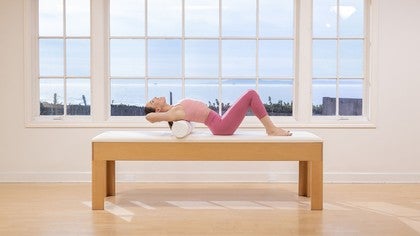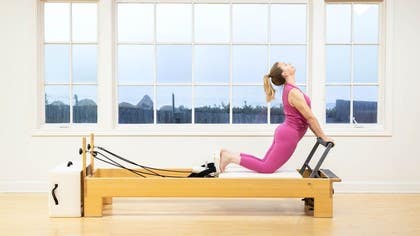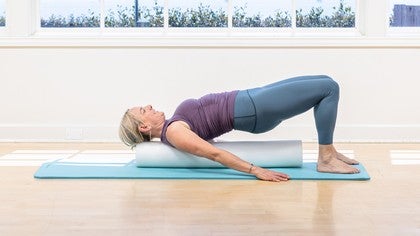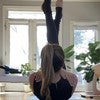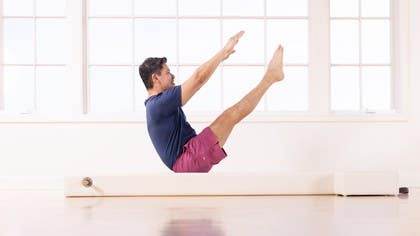
Becoming Empowered in Your Pilates Practice
Whether you are practicing under the watchful eye of an instructor in a private session, in a group class, or in your living room in front of a screen via Zoom or an on-demand platform, we've gathered some tips on making the most of your Pilates practice.
In Joseph Pilates' original studio on Eighth Avenue in New York City, clients worked independently on their own repertoire. According to Pilates lore, Joe or his wife Clara Pilates would roam the studio offering verbal or tactile feedback, sometimes adding a new exercise to the client's individual program.
Today, that form of class exists in some traditional Pilates studios, but it's more common to see an instructor doling out the exercises one at a time to their clients or class. Perhaps it's Pilates' reputation as a luxury service that has led students to become dependent on the instructor. That high level of personal service, however, might actually hold students back.
Gaining Independence in the Studio
What might it look like in today's studio setting for students to take ownership of their Pilates workouts? To find out, we spoke with says Regina Santos, a Los Angeles, California-based Pilates instructor and life coach with a robust private clientele. That's her pictured at the top of the page on the Reformer.
"I notice a greater sense of accomplishment and mental resilience from clients who take ownership of their practice instead of just being told what to do," she says. "When we are self-sufficient, we are more confident in the way we navigate through life. We are less prone to letting the outside world stress us out or to suffer from things like imposter syndrome," she adds.
Know Exercises and Your Order of Exercises
It might seem like a lot of work to commit to memorizing your Mat or Reformer sequence, but in time it will become second nature. "Knowing your exercises and order is like applying the base and top coat of a nail polish color: the benefits will last longer," says Santos. "When we know and understand the Pilates system, we can experience mind-body flow, deepen our practice, and progress in profound and astonishing ways," she adds.
Take Responsibility for Your Equipment
"Changing the springs and wrangling the Box develops our self-sufficiency. Being an active participant in our practice teaches us to integrate Pilates in our daily lives," says Santos.
Think about it this way: picking up and moving the Box is great practice for picking up a small child or safely unloading groceries from the trunk of your car. Changing the springs on the Reformer teaches us an efficient way to reach down to pet a dog or pick something up from the floor. Placing our feet under the strap for the Short Box series mimics the real-life skill of bending over to put on our socks and shoes.
Prioritize Your Time in the Studio
"When we prioritize our self-care, our relationships flourish and we make healthy decisions that align with our values," says Santos. For example, one of Santos' Pilates clients scheduled a family meeting around her standing Pilates workout. She and her sister had been negotiating some hard decisions for their elderly father. Santos' client felt that getting centered in her practice would allow her to work with her sister from a calm and centered place.
Making Online Workouts Work for You
"The pandemic and the rise of streaming workouts that you do from home has underscored the importance of taking ownership of your workout," says Gia Calhoun, a Los Angeles, California-based Pilates instructor and vice president at Pilates Anytime.
This is especially true if you're using a streaming platform as opposed to a live Zoom workout. There's no one watching you (neither classmates nor an instructor), you don't have to be in a certain place at a certain time, and you don't have to wear real workout gear. Maybe you are even working out in your PJs. All of that sets the stage for slacking off. So what can you do to make sure that you get an efficient and challenging workout when you are on your own? Here are Calhoun's suggestions.
"Becoming empowered when you are working out in front of a screen instead of a real person means that you don't let anything get in your way," says Calhoun. Commit to taking the time out of your day and don't let other tasks, people, or pets intrude, just as you would if you had driven to a studio and paid an instructor to teach you for an hour.
Have a Plan B if Tech Gets Snarled
If your video stops streaming at minute 20 of a 30-minute class, keep going on your own. Have a series of exercises that you know inside and out and that you enjoy. "Since you're already on your Mat or your Reformer, why not finish what you set out to do? You might surprise yourself with how much of the Pilates repertoire you know," says Calhoun.
Know Your Body
If there's an exercise that you can't do, either because you aren't familiar with it, it hurts, or you've been told by a doctor or physical therapist to avoid certain movements, have a modification in mind. "Do your own thing and return to the class when you are able. Don't stop moving, and don't use the opportunity as a 'get out of working out' pass," says Calhoun. Instead, draw on your own body wisdom and experience to find a modification or a substitute exercise. Says Tracey Mallett, a Pilates instructor based in Pasadena, California who is vocal about providing plenty of options for modifying exercises in her online workouts, "There's always a solution."
Use Your Ears as Well as Your Eyes
Working out in front of a screen means that at some points, you won't be able to see the instructor. Try to listen to the instructor's cues instead of just watching them. It's a good idea to repeat classes that you like or have a playlist of go-to classes. You'll be surprised how much more you get out of the work on repeated viewings, in part because you will know what's coming. "You'll get into the right position, really master the form, and feel the work right away instead of needing a few repetitions to get into the groove," says Calhoun.
"It's amazing what you can do in a small amount of time," says Mallett. "I've always said that through the whole of my career. It's about moving from one exercise to the other. The more you anticipate what's coming next and the further you can dig deeper into those exercises," she adds.
What are your favorite ways of taking ownership of your Pilates workout? Let us know in the comments below.
Comments
 Thank you, you've given me the incentive to get back into a more focused workout.
Thank you, you've given me the incentive to get back into a more focused workout. 
You need to be a subscriber to post a comment.
Please Log In or Create an Account to start your free trial.

